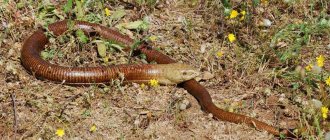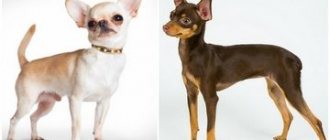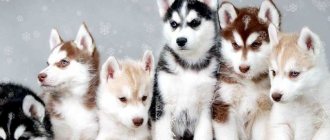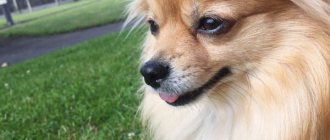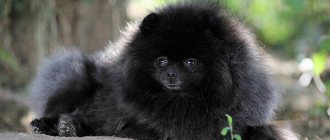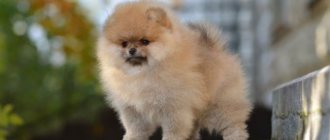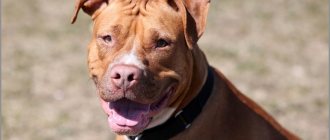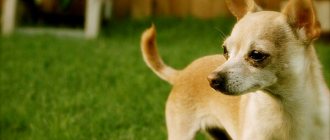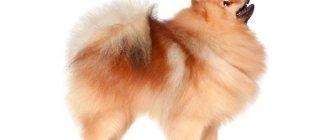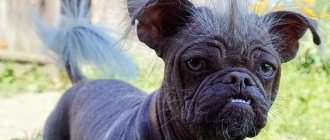Origin story
As already mentioned, the Keeshond is a fairly ancient breed. It is believed that the first Wolfspitz puppies appeared in the 16th century and these friendly animals were used as guards. This cute, smiling dog is native to Germany and the Netherlands. The breed is in some way unique, since for so many years since its inception its development has been natural. That is, unlike many other breeds, the Wolfspitz was practically not subjected to any genetic experiments aimed at changing its appearance.
Caring for Wolfspitz dogs
Having decided to get such a pet, you should take into account that raising a puppy will require a careful and thoughtful approach. Caring for Wolfspitz dogs is not easy; these animals are suitable for keeping both in apartment conditions and in the countryside. In both cases, the animal will need to clean out its long, thick fur using a special brush. Brushing is also useful because during this procedure the dog receives a skin massage that improves blood circulation. During periods between moults, this procedure should be performed 2–3 times a month. It is not recommended to do this too often, since frequent brushing will lead to a deterioration in the quality of the coat and undercoat. Males shed once a year, and females shed twice. At this time, lumps of hair appear in the apartment, which are very easily removed, since the hairs do not fall apart and do not stick to furniture and clothing. Shedding wool is combed out 2-3 times a week. Molting lasts 3 – 4 weeks.
The animal does not need frequent bathing; it is enough to wash it as soon as its fur gets dirty. Frequent bathing leads to skin irritation and loss of the protective coat.
How not to get confused by names
Some experts still believe that there are two different dog breeds: the German Wolfspitz and the Dutch Spitz. In fact, such a statement is not true. The fact is that the Keeshond was called “exchange dogs” in Holland, but the Wolfspitz is the official name for the same animals in Germany. When the Germans developed a breed standard for some varieties of Spitz, the Keeshond (stock dog from Holland) received its “second” German name - Wolfspitz. The officially recognized breed goes by both names – Wolfspitz/Keeshond. Despite the fact that this cute baby may be called differently in different countries, the essence does not change.
Description and breed standard
These are quite small dogs, whose body reaches half a meter in length (at best), and weighs on average 25–30 kg. They are built very proportionally, and despite their small dimensions, nothing prevents them from living a full life. The peculiarity of this breed is its very fluffy fur, which seems to stand on end, and a characteristic “fox” muzzle.
Similar article: Everything about professional and home spitz haircuts
Another distinctive feature is the presence of “glasses” in the eye area, which gives their face a funny expression. The eyes themselves are usually dark in color and almond-shaped. The ears are small and erect. The tail is tight, covered with thick fur, curled into a ring and pressed to the back. Another feature of these cute dogs is their constant “smile” - for this trait in the old days they were even nicknamed “smiling Dutchmen”.
As the name suggests (“wolf Spitz”), this dog cannot have any color other than wolf. Their coat is colored in various shades of gray, and there are no black, white or red representatives of this breed. But know that color is the only thing that these babies have in common with formidable wolves.
General characteristics of the Keeshond breed
Keeshonds are active, energetic and cheerful dogs. They are extroverts by temperament, they constantly need communication, they love outdoor games and travel. They are happy to accompany their owner on trips to nature and are inquisitive. These are ideal companions for tourists and athletes. They can be trained in various tricks and agility.
This lovable dog, who looks like a teddy bear, is always cheerful. A charming facial expression with a characteristic smile can lift anyone’s spirits and save anyone from depression. This Spitz is sometimes even called the “smiling Dutchman.” Keeshonds can be used in canistherapy, help the disabled and children with developmental disabilities. In the USA, thanks to their keen sense of smell and developed intuition, they are recognized as the best search dogs.
| Options | Characteristic |
| breed name | Keeshond, German Wolfspitz, Dutch Wolfspitz |
| breed group | Spitz and primitive breeds |
| a country | Germany, Holland |
| application | companion, guard |
| appearance features | lion's mane, small triangular ears, sharp muzzle, thick double coat of wolf color |
| life expectancy | 13-15 years old |
| height | 43-55 cm |
| weight | 25-30 kg |
| aggression | No |
| activity | high |
| intelligence | standard |
| training | light |
| care | Difficult coat care, sheds heavily |
pros
Keeshonds are friendly, peace-loving dogs. They are very attached to their owner and love children. They get along well in the same house with other pets and do not get into conflicts with dogs. This is an ideal companion for people leading an active lifestyle, the best family dog. The Keeshond's compact size and ability to adapt to any conditions make it possible to keep it in a city apartment. He is like a cat, attached to the house, so he is not prone to escape.
Representatives of the breed have several other advantages:
- attractive appearance;
- balanced temperament;
- good learning ability, flexibility;
- complete absence of aggression;
- devotion, fidelity;
- unpretentiousness;
- cleanliness, absence of dog smell;
- good health.
Minuses
Keeshonds are active, lively dogs. They need long walks and physical activity. Therefore, the breed is not suitable for homebodies, as well as for those who are often not at home. Wolf Spitz dogs are very sociable and require a lot of attention. They don't like to be alone. They have a few more disadvantages:
- the coat requires serious care, it sheds heavily;
- these dogs often bark loudly;
- prone to obesity;
- The breed is rare, so puppies are expensive.
Differences from other German Spitz
Keeshonds belong to the Wolfspitz breed. This is a variety of German Spitz. They differ from others in the size and color of their coat. Only this species can reach a height of 55 cm; these are the largest decorative Spitz. Their color is zonal gray or wolf, which is why the word “wolf” is present in the name. The rest of the German Spitz is divided into groups depending on size. The photo shows the features of the varieties of German Spitz:
Wolfspitz
Large Spitz or Grossspitz – 40-50 cm
Medium or Middle Spitz – 30-40 cm
Small or Kleinspitz – 24-30 cm
Miniature or Miniature Spitz – 18-24 cm
The International Canine Association does not recognize the independence of the Keeshond breed. His appearance is described by Wolfspitz standards. But in fact, Keeshonds are slightly more compact, have a fuller coat and a greater variety of colors. They look more attractive, since when reviving the breed, breeders bred a decorative dog. And when breeding German Wolfspitz, more attention was paid to working qualities.
Character traits
Dogs of this breed are very energetic and temperamental, they literally cannot sit still, they constantly need to move. They become very attached to their owner, sometimes they can even be jealous of others, but this is not a common occurrence. They are very friendly, especially towards children. They are excellent watchmen and security guards, but are more prone to constant communication with humans. These dogs are also used by psychotherapists, since they are very sensitive to changes in a person’s mood, and the patients themselves often make contact with them.
Maintenance and care
The Keeshond does not require special care; the dog feels great in an apartment. Food, walking, communication with the pet - all the conditions for keeping this dog are quite standard. An additional point to consider is Pomeranian shedding. Of course, he has a luxurious thick coat, but it can do a disservice to the pet owner, since all the furniture and carpets will be covered with six. In order to solve this problem, it is necessary to regularly comb the animal, removing unnecessary hair.
Similar article: Characteristics and maintenance of the American Eskimo Spitz
In addition, at first glance it seems that a dog with such a coat needs to be bathed often, but this is not the case. It should be bathed rarely, and a non-aggressive shampoo should be used for this. Also keep in mind that when purchasing such a friend, you must come to terms with the fact that his fur is thick, long and fluffy. Under no circumstances should they be cut - the fur must retain its original shape.
Health
The average life expectancy of a German Spitz is 15-16 years.
It mainly depends on the conditions of detention and veterinary care.
The owner must vaccinate the dog according to the established schedule, carry out regular deworming and treatment for skin parasites.
It is recommended to show your Keeshond to specialists at a veterinary clinic annually. Such preventive examinations will help to detect health problems in time.
Treatment at the initial stage is known to be much more effective than fighting an advanced disease.
It is also important that the owner is aware of what diseases his pet is predisposed to. Characteristics of the Wolfspitz are outlined below:
- Epilepsy - accompanied by seizures, convulsions, cannot be treated, but a person, with the help of medications and proper handling of the animal, can control attacks, reducing their number.
- Hypoadrenocorticism is an endocrine pathology.
- Allergies – often occur to food. Therefore, it is important to carefully and gradually introduce new foods into the diet or change the type of dry food.
- Dysplasia – contributes to the development of arthritis, characterized by unbearable pain and lameness.
- Cataracts are an eye disease that severely impairs vision to the point of blindness.
- Knee dislocation is a genetically inherited bilateral pathology.
- Hypothyroidism is a deficiency of circulating thyroid hormones in the Keeshond's blood.
- Progressive retinal atrophy develops in both eyes at once and always leads to complete blindness.
- Diabetes mellitus cannot be completely cured, but requires control, proper diet and medications.
- Obesity comes from overeating, poor nutrition and a sedentary lifestyle. Leads to disruptions in the gastrointestinal tract and cardiovascular diseases.
- Von Willebrand disease develops when there is a defective von Willebrand factor in the blood or a deficiency of it in the blood.
How to feed a Keeshond
A few words about dog nutrition. In fact, choosing the right food for your pet is not at all difficult, given the huge abundance of food presented by various manufacturers. You can also feed your pet natural food, but in this case you should not rely on luck. Contact your veterinarian or the breeder from whom you purchased your Wolfspitz. Let the professionals create a diet for your pet.
Education and training
Representatives of this breed are distinguished by a fairly high level of intelligence, so they are able to understand their owner at a glance. They are very easy to train, and raising a Wolfspitz is completely unproblematic. The only difficulty may be the irrepressible enthusiasm of the puppies, who do not sit still for a minute. However, with age this goes away and the dog becomes calmer. But in any case, you will have to organize an active walk for them and, perhaps, even come up with outdoor games. But don’t let your pet off the leash - he is quite capable of finding adventures that will negatively affect his health.
It is important to remember that these dogs should never be physically punished. Their level of intelligence allows them to understand the mood of the owner by the tone of their voice or an angry look. When training a Keeshond, he is taught standard commands. Of course, if you want your pet to take part in exhibitions, you should add to this the ability to parade in front of the public and stand up.
Related article: How to choose a healthy and beautiful Pomeranian
In general, you can train a Spitz yourself, but if you want to achieve better results, contact a dog trainer. This is not a cheap pleasure, but your baby will obey any command. Dog trainers should also be contacted when the dog requires behavioral adjustments. As a rule, this happens during puppyhood, since an adult dog is much more difficult to retrain.
Approximate cost and choice of puppy
Keeshond puppies are quite expensive. Depending on whether the dog has a good pedigree (and therefore what its chances of winning at exhibitions are), the price can range from 15 to 40 thousand rubles. You should only choose a puppy from specialized nurseries and from breeders you trust. Be sure to look at the conditions in which the dog is kept. The kennel must be clean, and the puppy itself must be active, healthy and fed. The owner of the nursery must provide you with all the necessary documents and tell you in detail about the maintenance of the pet, in particular, agree on the diet.
How to buy a puppy
To buy a purebred Wolf Spitz puppy, it is better to contact a professional nursery. There the dogs are kept in the right conditions, and studies are carried out for genetic pathologies. Puppies are usually sold at 2 months, but if the dog is needed for exhibitions, it is better to wait until 4 months. At this age, breed characteristics are better visible. Pedigree Keeshond puppies cost from 20 thousand rubles. The price for show class specimens is higher – 40-50 thousand. If a dog is offered cheaper, it may be without documents or with hereditary diseases.
When choosing a puppy, you first need to pay attention to the living conditions of the animals and the behavior of the mother. It is important to study all documents and veterinary certificates. Puppies should be well-fed, active, and playful. It is necessary to check the thickness of the coat, study the color, bite, and position of the limbs. A healthy puppy has clean eyes, a wet nose, no unpleasant odor, and a soft tummy.
The photographs show what the puppies look like:
An interesting video will complement the characteristics of the breed:
Video: Wolf Spitz (Keeshond). Pros and cons of the Wolfspitz breed
Video: Keeshond. Breed characteristics, care
Video: “Home Zoo” program about Wolfspitz (Keeshond)
The Keeshond is a cheerful, good-natured dog with an attractive appearance. If you give her enough attention and take her out into nature more often, she will become your best friend, loyal and obedient.
Video “Wolf Spitz or Keeshond”
From this video you will learn everything about the Wolf Spitz breed.
Recommended Posts
Standard height and weight of the Cane Corso breed by month
Weight of a puppy and an adult Labrador by month
Weight and height of a German Shepherd puppy by month
Description and content of the hunting border terrier
TOP 40 best hunting dog breeds with names, descriptions and photos
Description and care of the highly intelligent Border Collie breed
Breed traits
Breed traits (on a 5-point scale)
| Keeshond (Dutch Wolf Spitz) | |||
| Activity | in the house | 2.4 | |
| on the street | 3.2 | ||
| Obedience | training | 4.1 | |
| strangers | 3.8 | ||
| Domination | in family | 1.7 | |
| over dogs | 2.1 | ||
| Defending your territory | from people | 1.9 | |
| from dogs | 2.2 | ||
| Sociability | in family | 4.8 | |
| with strangers | 4 | ||
| with dogs | 3.4 | ||
| Concentration | in family | 1.2 | |
| in front of strangers | 1.6 | ||
| with dogs | 2 | ||
| Aggressiveness | in family | 1 | |
| to strangers | 1.4 | ||
| to the dogs | 1.9 | ||
| to cats | 1.5 | ||
| Family behavior | calmness | 4.8 | |
| demand for affection | 4.7 | ||
| excitability | 3.9 | ||
| playfulness | 3.8 | ||
| excessive barking | 3.1 | ||
| behavioral breakdowns | 1.8 | ||
| Tolerance for children | up to 4 years | 4 | |
| over 4 years old | 4.4 | ||
| Institutional use | watchman | 4.5 | |
| bodyguard | 1.7 | ||
This breed is often compared to the following dog breeds: Samoyed, Cavalier King Charles Spaniel, Shiba Inu, Miniature Schnauzer, Pekingese.
Photos of Keeshonds:
